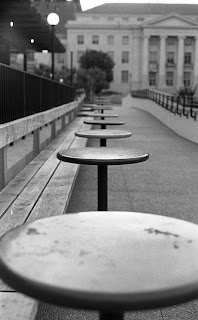 |
| Card design by Samara Pearlstein |
When the snow starts falling, my photographic output falls a bit, until I get my mindset aligned with the change of seasons. First of all, doing any photography in the winter can be a challenge, depending on the severity of conditions. There are factors that work against you, aside from getting cold fingers.
Keep your gear from getting wet. Snow can cause havoc -- and if you are in a snowstorm, you really don't want it on your lenses. An easy way to keep the snow off the front element is to just use a skylight filter on the front. It will making cleaning it off a lot easier. Use a soft cloth, such as a piece of an old t-shirt to wipe off the snow or condensation. A micro-fiber cloth for fogged lenses usually works pretty well, and a lens hood also helps to keep snow from the front of the lens.
Try to avoid changing lenses, but if you must, keep them wrapped in a cloth until you need them. There are lens wraps available that protect lenses quite well. Changing lenses in the cold weather with cold fingers is a good time to have a case of the fumbling fingers appear.
Some cameras are just harder to use in the cold -- folding cameras are a good example. The bellows get stiff, controls fiddly, and so on. All-metal cameras with small dials and metal lens barrels also may become difficult to use. While I wear gloves or mittens with flip-away tips, my fingers get cold from handling equipment, and it helps to have a warmer in your pocket. Carrying a tripod is another source of cold hands, so use some pieces of foam pipe insulation and tape them over the topmost leg section. It really makes a huge difference.
If it gets, really, really cold, you can strip the sprockets right off the film with a motor-drive. If you are shooting film, I advise you to use as simple a camera as possible for below-zero conditions. A Nikon FM2N, Pentax K1000, or similar camera will be ideal. If you are shooting digital, keep spare batteries inside your coat. Nikon made an external battery holder (DB-2) for the FM and FM2N and similar cameras-- it has two AAs with a long cord that screws into the battery compartment - keeping the battery inside your coat. Cold dry air can cause static discharge on the film as it is wound or rewound. I have had that happen only once, and it wasn't all that cold. It was an "interesting" effect on the negatives. So, another reason to wind slowly. While I doubt that most of us would find ourselves in the Antarctic, under those conditions, film has simply shredded as it was wound. So, under ultra-cold conditions, digital
may be the better choice!
I tend to shoot mostly nature scenes in winter, but street shooting has it rewards, too. However, a pocket camera works well in winter, and something like an Olympus RC or Trip 35 is easy to use with gloves. Holgas are great for winter, too. Nothing much to adjust, and with some b&w film, those snow scenes could be even more interesting shot with a Holga.
Keep your hands, feet, and head protected in winter. The rest will be fine if you do that. The clothing available now for winter wear is amazing, and dressing in layers is still the best way to go about it.
One last bit of advice -- experienced photographers already know this-- but remember to adjust your exposures for snow. Generally, 1 to 2 stops more exposure than your meter is telling you. Sunny-16 in winter is a wonderful thing.
To close up, here are a few recent images that I shot on the
FPP- Mr. Brown ISO 6 film. It was snowing heavily, and I used a Canon EOS Rebel 2000 (all-plastic) at ISO 8. The film was developed in XTOL 1:1 for 10 minutes. I think the results are pretty good.
 |
The gray smudge at lower center is a walker in the woods.
Long exposures! |
I turned 60 last Monday, so I better be getting my senior discount now, but unfortunately it does not apply to film purchases! Stay warm, stay positive, and keep shooting film. I know that I will.
















